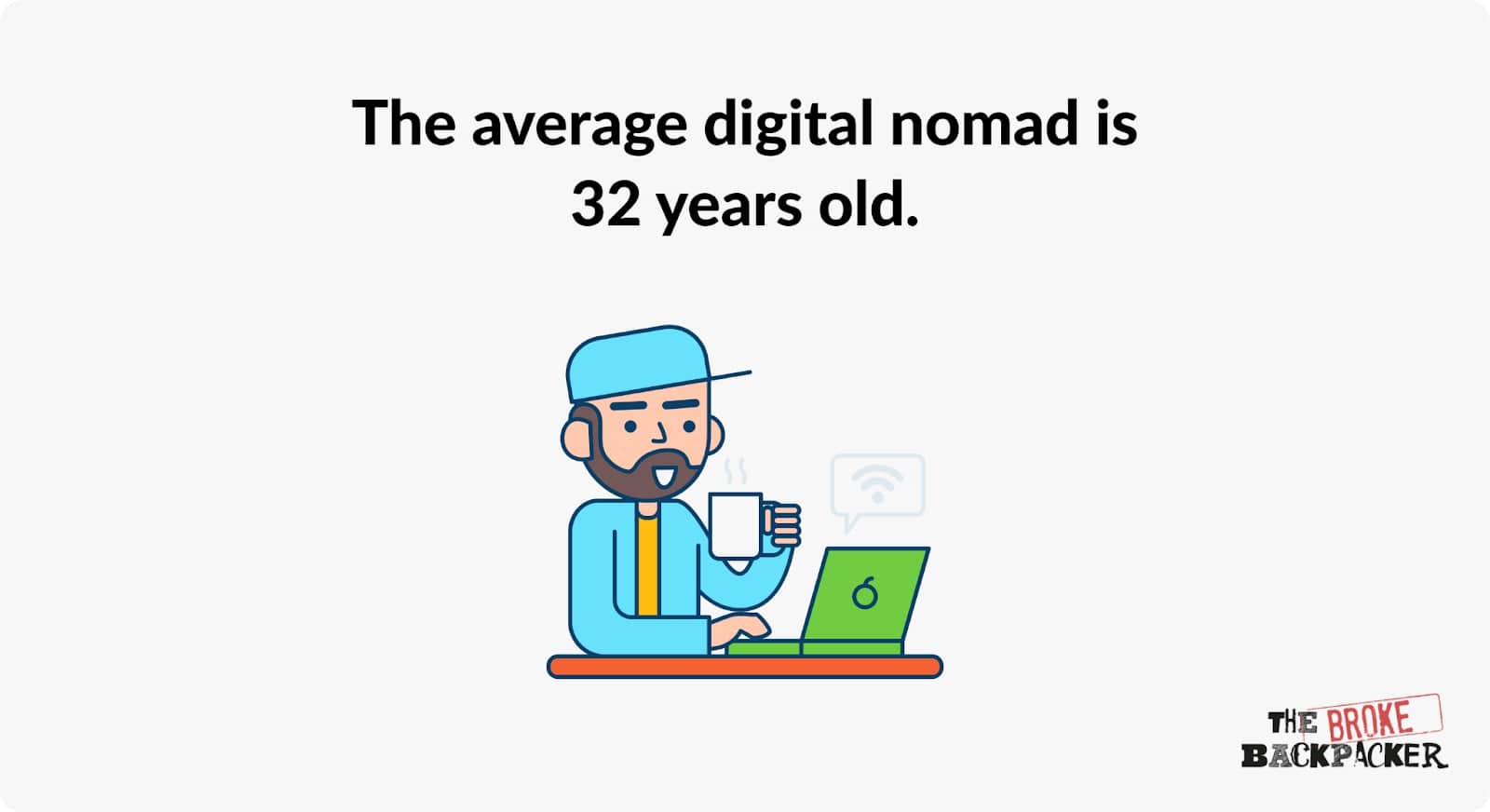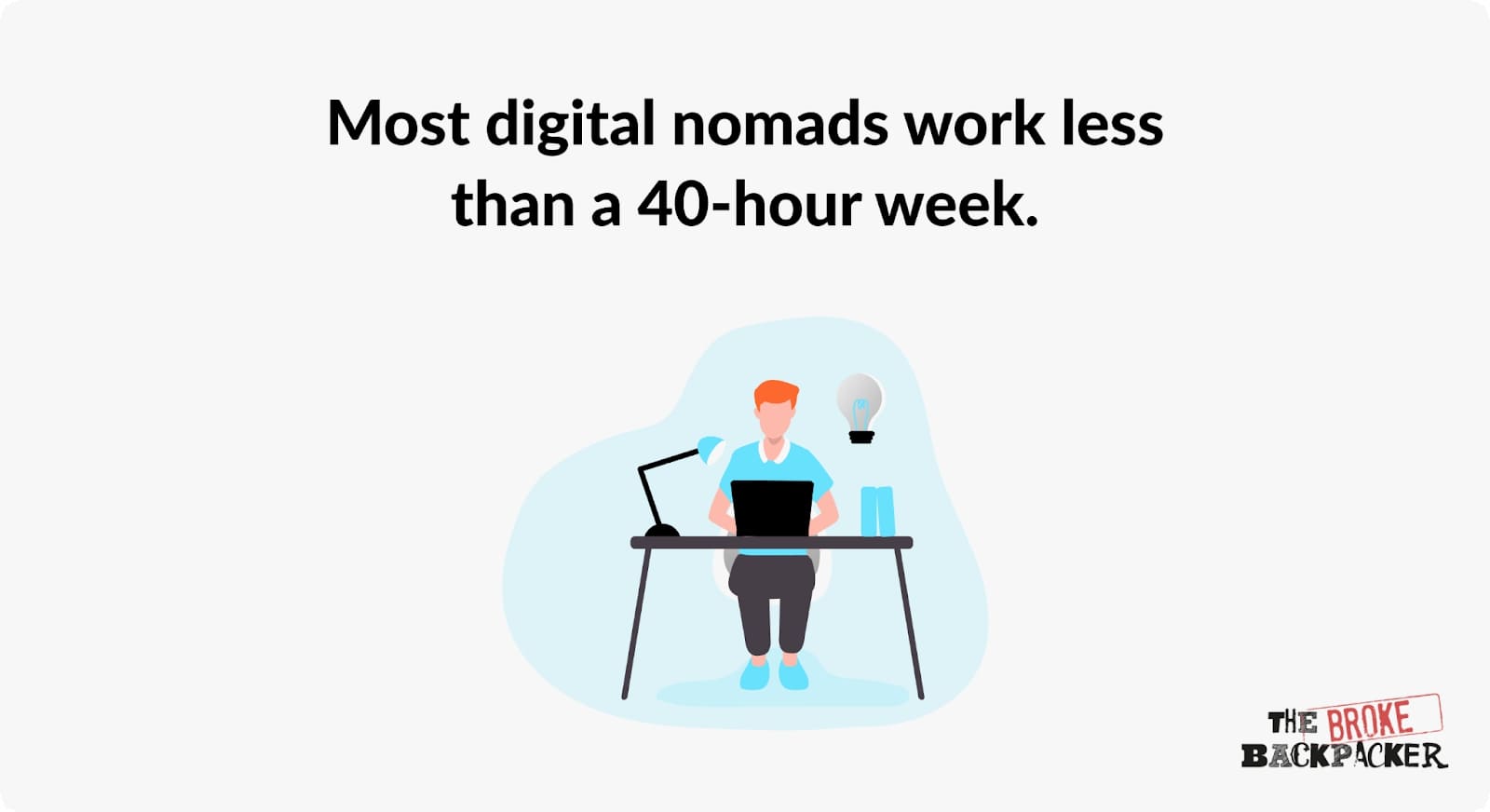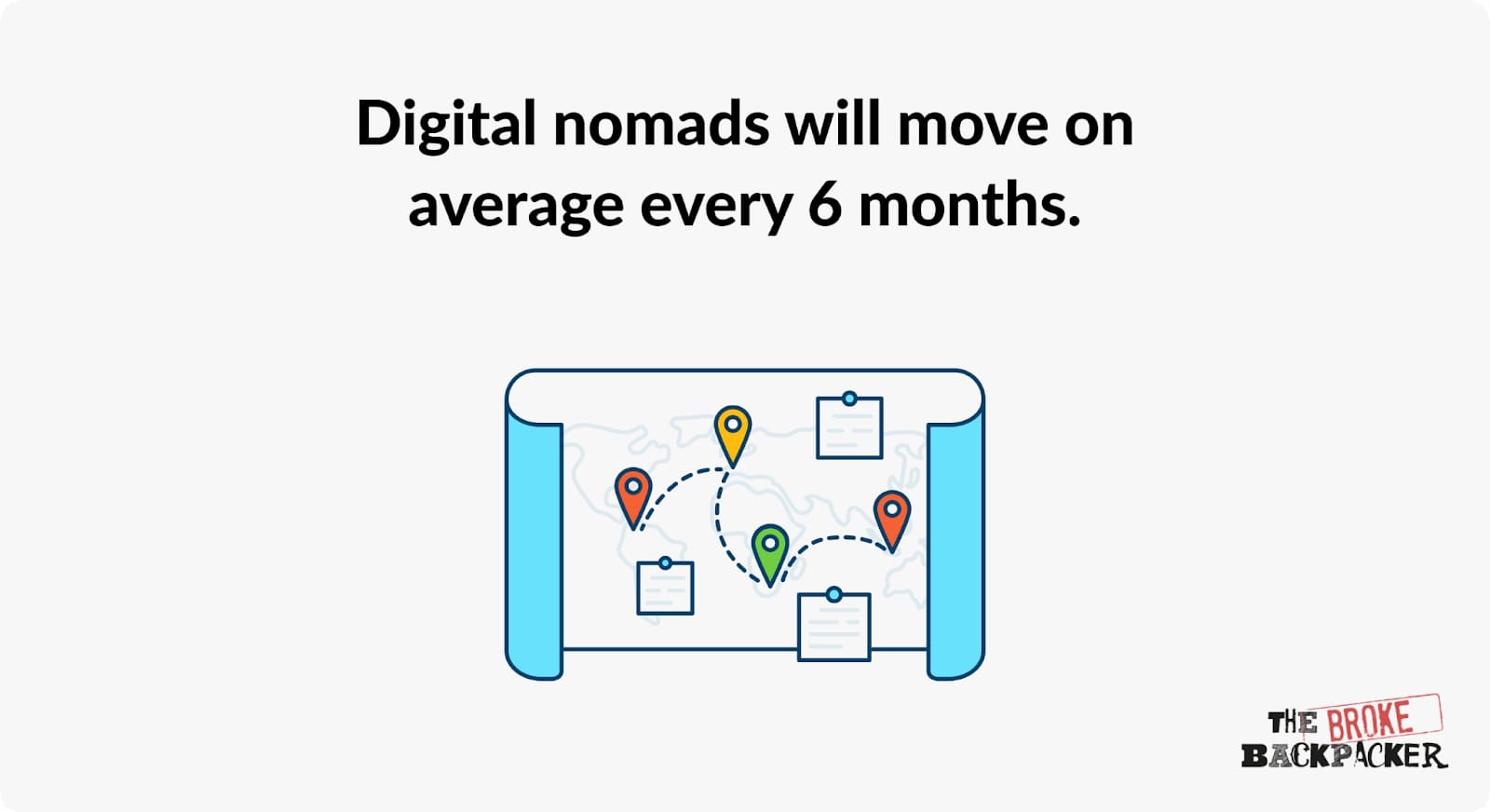The Broke Backpacker is supported by you. Clicking through our links may earn us a small affiliate commission, and that's what allows us to keep producing free content 🙂 Learn more.
Digital nomads are taking over the world. Every cafe has a coffee sipping entrepreneur typing vigorously on their laptop, every friend group has that one friend who is chasing the next big crypto trend, and we all know someone who is striving for TikTok fame.
But, what actually is a digital nomad?
Far from the office 9-5’s that our parents consider ‘the norm’, here is everything you need to know about digital nomads!
You’re about to see a list of the newest digital nomad statistics, facts and trends.
Let’s see some stats!

Photo: @amandaadraper
The Broke Backpacker is supported by you. Clicking through our links may earn us a small affiliate commission, and that's what allows us to keep producing free content 🙂 Learn more.
Summary Of Digital Nomad Statistics
- Worldwide, there are 35 million digital nomads in 2021. [1]
- The number of digital nomads in the US has more than doubled over the past couple years—from 4.8 million in 2018 to more than 11 million in 2021.
- Most digital nomads live in hotels (51%), then with friends/family (41%), Airbnb (36%), car/RV/van (21%), and hostels (16%).
- Most digital nomads are married (61%), and 39% are unmarried.
- The average digital nomad is 32 years old.
- 70% of digital nomads work 40 hours per week or fewer.
- 80% of digital nomads stay in one place between 3 to 9 months, and 66% stay in one place between 3 to 6 months. [1]
- The average digital nomad makes $119,423 a year.
- Digital nomads will move on average every 6 months.
- Around 50% of remote employees say that finding WiFi is their biggest challenge.
“Broke but Backpacking” is a WhatsApp community full of passionate travellers. A space to connect with like-minded backpackers and be the first to hear about exclusive deals and giveaways designed just for the community.
If you’re looking for tips, stories, and inspiration about working remotely or embracing the digital nomad lifestyle, you should 100% join the legends in our “Remote Work/ Digital Nomadism” group chat.
Join the CrewAll Statistics
| Digital nomads worldwide | 35 million |
| Digital nomads in the USA | 11 million |
| Average age of a digital nomad | 32 years old |
| Digital nomad average salary | $119,423 |
| Digital nomad relationships | 61% are married, 39% are unmarried |
| Digital nomad biggest challenge | Finding WiFi |
| Digital nomad work hours | < 40 hours/week |
What is a Digital Nomad?
The definition of a digital nomad is someone that works remotely, but is constantly traveling from one place to another.
They rely on portable devices with wireless internet capabilities, such as laptops, tablets and smart phones to do their work wherever they want.
People choose the digital nomad lifestyle because they want to be able to work remotely, and have more time to do the things they love.
They often have different needs when it comes to packing for their trips, you can check out our digital nomad packing list for some ideas of what that entails.
How many digital nomads are there worldwide?
Worldwide, there were 35 million digital nomads in 2021!

It is expected that the total amount of digital nomads in the world could double within just a few years!
Digital nomads can be found in every city. Some are locals and others immigrants.
Many digital nomads enjoy traveling to new places. Since their jobs are completely remote, a digital nomad can go anywhere they want, so long as it fits within their budget.
Even with jobs beginning to see automation become more important for day-to-day business activities, the trend isn’t likely to impact remote employment to a significant degree.
How many digital nomads are there in the US?
The number of digital nomads in the US has more than doubled over the past couple years—from 4.8 million in 2018 to more than 11 million in 2021!

The United States is a leader in remote jobs, outpacing other countries in the variety of work capable of being done remotely, and the number of remote employees.
Everything from programmers, to people in the healthcare industry, can find employment spread out between each of the 50 states. The majority of them staffed by people either partially or fully employed at long distances.
Because of the US’s size, it’s not uncommon to see digital nomads move between states, traveling around the country, and living in temporary accommodations.
Where do digital nomads live?
The majority of nomads live in hotels (51%), then with friends/family (41%), Airbnb (36%), car/RV/van (21%), and hostels (16%).
What do digital nomads get whilst living abroad?
You guessed it, travel insurance. Enter SafetyWing.
Month to month payments, no lock-in contracts, and no itineraries required: that’s the exact kind of insurance digital nomads and long-term traveller types need. Cover yo’ pretty little self while you live the DREAM!
SafetyWing is cheap, easy, and admin-free: just sign up lickety-split so you can get back to work! Click the button below to learn more about SafetyWing’s setup or read our insider review for the full tasty scoop.
Most Popular Fields For Digital Nomads
FlexJobs asked digital nomads to choose the career field they work in – these were the 10 most popular:
- Writing
- Education & Training
- Administrative
- Customer Service
- Art & Creative
- Computer & IT
- Consulting
- Data Entry
- Marketing
- Project Management
Families of Digital Nomads
- Marriage: Most digital nomads are married (61%), and 39% are unmarried.
- Children: Only 26% of digital nomads have children 18 and under.
- Schooling For Nomad Kids: The majority of nomads’ kids are enrolled in public school to meet their educational needs. Nomad kids are also sometimes homeschooled and learn online.
What is the average age of a digital nomad?
The average digital nomad is 32 years old.

The lifestyle that digital nomads live is attractive to young adults, particularly those in their early to mid-30s. However, there are workers within each age demographic, including the baby boomers and Generation X.
Nomads tend to have few, or no, children. Those with children are likely to avoid traveling for long periods of time.
Some remote workers are younger, ranging from the Gen-Z to late Millennials. The second-largest age group is over 40.
How many hours do digital nomads work?
70% of digital nomads work 40 hours per week or fewer, 33% of digital nomads work more than 40 hours per week.

Those that do part-time work might look for employment with several companies, therefore, their total number of work hours in a week might be higher than someone working full-time with one company.
Full-time remote workers don’t make up a large percentage of the total amount of digital nomads.
Soon, this could change, especially if the average salaries of digital nomads increase.
People tend to gravitate toward jobs that pay well, have hours that are comfortable for them, and provide enough hours to keep them from having to find a second job.
How long do digital nomads stay in one place?
80% of digital nomads stay in one place for 3 to 9 months, and 66% stay in one place between 3 to 6 months. [1]

Some digital nomads prefer to stay in one place for a few days, while others stay up to a few months.
Digital nomads must make sure that they can afford the place they’d like to travel to.
It’s common to find digital nomads in places with inexpensive food and housing, such as Southeast Asia.
Some digital nomads settle down in a new country or city once they find a place that meets their preferences.
When this happens, they may stay a year, or move to a different location that’s not far away from their previous living area.
Digital nomads living outside of their home country may have to switch visas, forcing them to leave one country for another, or come right back to where they were on a new visa.
Visas fill a legal vacuum for nomads who wish to spend periods of time abroad working independently.
Extensions are about the same as the average time they move, about six months.

Photo: @joemiddlehurst
How much does the average digital nomad make?
The average digital nomad makes $119,423 a year.
| Nomads By Income | % |
|---|---|
| < $25k / y | 6% |
| $25k - $50k / y | 18% |
| $50k - $100k / y | 34% |
| $100k - $250k / y | 34% |
| > $250k / y | 8% |
| Average | $119,423 / y |
| Median | $80,000 / y |
Digital nomads making six-figure salaries (or close to them) usually hold a degree in a high-demand field.
Higher pay can also come from them managing their own business, investing in stock or cryptocurrency, and working short-term or seasonal jobs in the temporary place they call home.
How often do digital nomads move?
Digital nomads will move on average every 6 months.

If a digital nomad was to stay in one place for a long time, the lifestyle wouldn’t be referred to as such. Remote work appeals to people that dislike the feeling of being bogged down for a long time.
Younger digital nomads like to travel the most often, and are more willing to move to a different place quicker than others.
Some digital nomads like to stay in a place for one or more years, living the life of an expat.
The place where digital nomads live plays a role in how long they will stay there. When safe housing is available, nomads will likely stay there longer.
Digital nomad demographics
The majority of digital nomads are men (79%), while 20% of nomads are women. 1% of digital nomads describe themselves as “Other”.
70% of remote workers are of European descent, 7% are Hispanic, and 14% are African American.
Digital nomads come in every ethnicity, gender, and age. They are found globally and are reliable, productive workers for the businesses that employ them.
This makeup of digital nomads is for the US, where the largest population of them resides.
The numbers aren’t surprising, as they closely reflect the demographics of the country as a whole.
Worldwide, most digital nomads are also of European descent, though most ethnicities have high counts when their home country has few visa restrictions.
What is the biggest challenge digital nomads face?
Around 50% of remote employees say that finding WiFi is their biggest challenge.

Digital nomads, by nature, rely on the internet or computers to complete their work. If their connection is spotty or lacks reliability, it can become difficult for them to complete their jobs.
Nomads sometimes live in automobiles such as caravans, vans, and other mobile vehicles.
Unfortunately, internet connection in these situations is sometimes unpredictable.
Therefore, remote workers must pay for an internet service that’s speedy, and doesn’t require constant maintenance and troubleshooting to keep it running. One way to solve this is to invest in a high-quality travel router.
As tech becomes more sophisticated, the reliability of remote workers and their means of networking should ease up in the future.

Photo: @monteiro.online
Fun Facts About Digital Nomads
What do digital nomads do?
18% of transient workers own their own company, 35% are employed by a business, and 28% are freelancers.
These figures have gone up in the last two years. As more workers look for work outside of the office or business establishment. The number of digital nomads will grow regardless of a stalemate in the economy.
What do digital nomads need?
Besides food, water, and shelter, a digital nomad needs:
- A non-distracting work environment
- Hotspot/WiFi
- Travel Bag
- Electronics Organizer
- Portable Charger
- Headphones/Headset
- External Hard Drive
- Lap Desk
Most digital nomads aren’t picky and are willing to adapt to the environment they live in. This being said, the ability to talk and interact with people regularly helps to encourage productive work.
How do digital nomads get their food?
80% of digital nomads purchase groceries and cook.
The cheapest option for eating is for them to cook their meals.
Nomads tend to live in places where food is cheaper.
What do nomads eat?
74% of male nomads eat meat. 47% of female nomads don’t eat meat. 12% of nomads are vegetarian. 13% are vegan, and 5% are pescatarian.

Photo: @danielle_wyatt
How long have digital nomads been around?
Jobs descriptive of a digital nomad lifestyle began in 1983. That year, one of the first digital nomads, Steve Roberts, rode on a computerized recumbent bicycle.
What started as a cyclist riding cross country on a computerized bicycle quickly morphed into a way of life, one that has increased rapidly beginning in the early 1990s.
Are digital nomads rich?
Digital nomads aren’t rich, though some are making a good income and saving money from having a lack of responsibilities typical of living in a home or apartment for long periods.
Summary
The life of a digital nomad is exciting and filled with adventure. More people will consider adopting a traveler’s lifestyle, either locally or internationally.
Remote jobs are constantly being created by new and old companies alike, a trend likely to continue over the next ten years.









